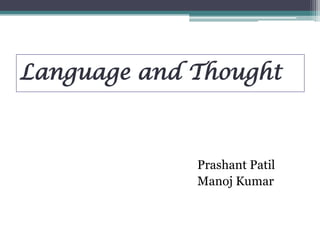
Language and Thought: How Language Shapes Perception
- 1. Language and Thought Prashant Patil Manoj Kumar
- 2. Introducing the topic • If think we can‟t think clearly without using language? then how about.. - deaf and mute people? - children two-three years old? Their language is certainly not adequate enough.
- 3. Views of some theorists • Classical theorists like Plato and Aristotle argued that the categories of thoughts determine the categories of language. • Plato: Thought and language were identical. • Aristotle: Mankind could not have the same languages (because all don‟t think the same).
- 4. • J. B. Watson: Thought is language; sub-vocal speech. “think aloud” = speech; “speak covertly”= thinking.
- 5. Two opinions for the prior discussion The notion of language and thought and their relation subsequently got divided into two groups mainly: 1. Whether thoughts are formed in advance of the words that we utter. 2. Or whether ideas are formed in terms of the words themselves.
- 6. Language determines thought • The Eskimo language for snow: apun= “snow on the ground”, qanikca= “hard snow on the ground”, utak= “block of snow” etc. • An Eskimo child -> more cognitive categories. • English - camel, Chinese - luòtuo, Arabic - more than 400 words for the animal.
- 7. The Sapir–Whorf hypothesis The hypothesis in linguistics has two versions: • The first is called linguistic determinism (the strong version) • The second part is called linguistic relativity (the weak version)
- 8. Linguistic determinism: • It is the idea that language and its structures limit and determine human knowledge or thought. • Whorf states that language does not only voice ideas but also shapes them. • [The child‟s knowledge is socially constructed in interaction with adults, so child logic develops only with the growth of child‟s social speech.]
- 9. Linguistic relativity: • Speakers of different languages - perceive the world differently. - resulting cognitive systems are different. • Accordingly the mental universe of an English speaker may be different from that of a Chinese speaker because they happen to speak different languages.
- 10. • Take „rainbow‟ as an example: perception of colors come from color-naming influence of the language. All languages do not divide the colors into the same number of basic categories. Hence a speaker of a language will not describe the rainbow in the same way as English speakers do.
- 11. B. Berlin and P. Kay’s experiment in 1969 • Concerned with how speakers of different languages divide up the color spectrum. • They used an array of 329 colors, presented to speakers of 20 diverse languages. • First, Berlin and Kay found basic color terms in each language. They then presented to the speaker of a language and asked to name the colors and draw lines around distinguishable ones. • After that, all 20 were asked to mark with an “X” the most typical example of each color in their basic color vocabulary. This was called the focal color.
- 12. Observations • The basic color terms were restricted to a small set of numbers. • The focal colors are the same across all 20 languages. Like if A had 4 and B six, these 4 closely corresponded to 4 out of the 6 colors chosen by B.
- 13. • Swedish -many different names for colours (for example: blue, red, white, light grey, purple, and cyan). • Tiv (language of New Guinea) -there are only two words for colour: light and dark. • Yet both language speakers could distinguish colours in similar manner.
- 14. Contrary to Sapir-Whorf Hypothesis • If there are no constraints on the variation in the way people think, speakers of different languages will never see the world in the same way. • If language determines thought, people speaking diverse languages would never understand each other. • Control the language that people learn, control their thoughts.
- 15. • We cant conclude strictly but little dependency and similarities.
- 16. Another question to think • Does the fact that a language does not have separate terms for certain phenomena means that the users of this language are unable to distinguish these phenomena from others?
- 17. Counterclaims: • There are bilinguals among the general population who can express their ideas freely in two or more languages. • Languages borrow words from each other fairly frequently. • Also used in sentence thing, compare with the two speakers.
- 18. Other ways for thinking.. • Pictures and feelings though hard sometimes to express thoughts. • Deaf people probably "see" more images in their thoughts. Symbols have a more important role. • The hypothesis has been largely abandoned due to limited support all through at its best.
- 19. Thought determines language • Those who believe this would say that cognitive development comes earlier in the life of children. • Cognitive categories they develop determine the linguistic categories that they will acquire.
- 20. • An instance that shows that thoughts and language are closely connected and thought processes have influence on our language is the course of a conversation.
- 21. Language of thought - Mentalese • Thinking is done in the form of a silent monologue. • According to LOTH, thought and thinking are done in a mental language a kind of 'language' (not a verbal language) that Pinker calls 'Mentalese', On this model, the mind functions like a computer, manipulating simple symbols to produce complex results. • Mental computations in a symbolic system physically realized in the brain.
- 22. THANK YOU!
